Methods for the destruction of crimson creeping: agrochemical, chemical and folk methods.
Contents
- Piles creeping: how does it look at the beginning of spring, how does it multiply, on what soils grows?
- Pyre: how to get rid of chemistry, herbicides, wheat grass poisoning
- Fighting with grasshoppers in the garden: round
- Remedy for grass: hurricane
- Citrass against grassgrass
- Remedy for digging in potatoes
- Manual disposal with dusting in small areas: video
- How to get rid ofwheatgrass in a strawberry?
- How to choose the right herbicide, video
- How to get rid of wheatgrass in raspberry: herbicide
- How to deal with grasshopper on the lawn?
- Combating stamping with folk remedies
- Destroying weeds using a blowtorch: video
- Combating stubble in the vegetable garden with vinegar
- Pumpkin against grasshopping
- The right advice: how to effectively deal with weeds on the site?
- The victory over the stubble-free chemical preparations - finally and irrevocably: video
A pier in the suburban area? Can not output? We'll show you how to get rid of the "creeping" conqueror of the earth forever.
Piles creeping: how it looks in the beginning of spring, how it multiplies, what kind of soil does it grow on?
Pyrée is a perennial weed that spreads rapidly on the land and delivers a lot of trouble for growers. Before we tell how to deal with a malignant weed, imagine it in all its glory. As they say, the enemy must be known in person.
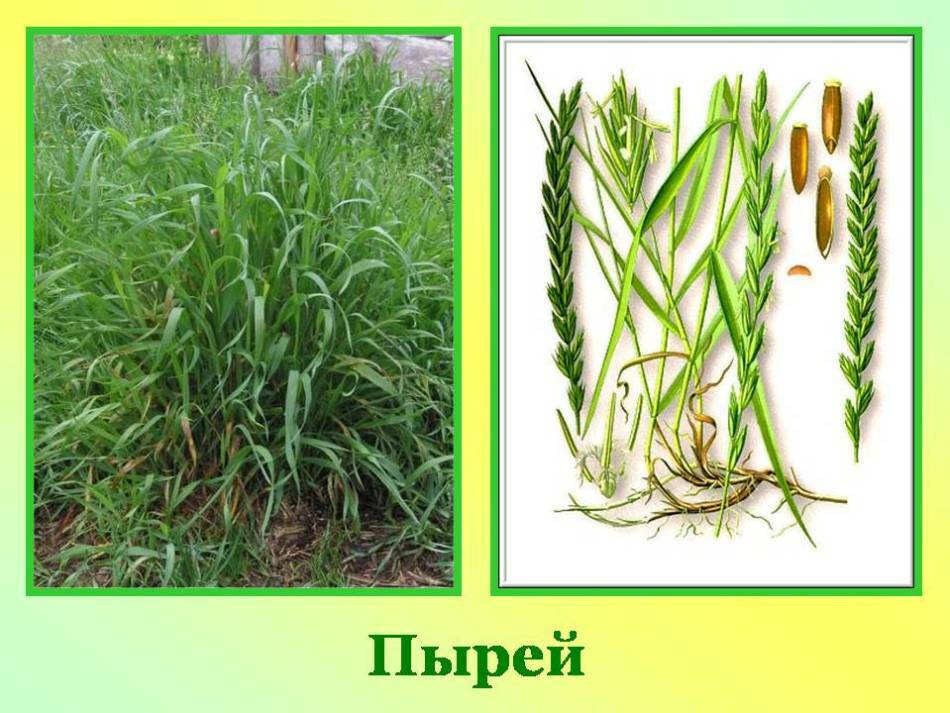 Creeping creep
Creeping creep - Elytrigia repens is a grassy herb with a creeping branchy rhizome, lying at a depth of 15 cm or more, rapidly spreading over large areas. The root system of the plant can cover the territory up to 3 meters.
- . It has folk names: rust, dog tooth, diver. The weed grows rapidly and can reach a height of 1.5 m. Long linear leaves are green with a bluish tint. Has a flower in the form of erect ear
- Weed can grow on different types of soil, even strongly acidified. The ability of seed and vegetative propagation( pieces of rhizome), unpretentiousness, greater resistance to drought and frost, rapid "conquest" of land areas, all this gives rise to the reason of creeping to the most malignant weeds
- Seeds of wheat grass germinate already in March-May at a temperature of +2+ 4 °.The pointed elongated ribbon leaves are lodged from the soil, while a powerful rhizome is formed, which rapidly spreads and throws new plants onto the surface of the
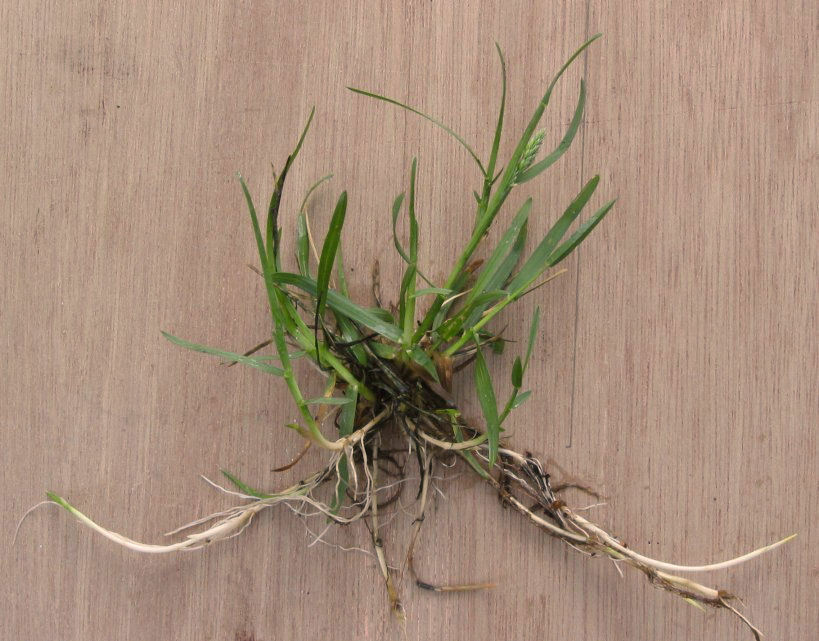 . Paddies are creeping with the
. Paddies are creeping with the rhizome. Pyrus: how to get rid of chemistry, herbicides, wheat grass poisoning
Herbicides
Chemicals to combatgreen pest have proved their effectiveness and speed of action. Systemic chemical reagents penetrate throughout the plant during spraying and act disastrously on the weed.
Important: The choice of the herbicide should be based on the goal of achieving the effect: continuous removal of all plants in a given area or selective effects.
If you need to remove all the plants on the path or between the paving slabs - apply herbicides continuous action. On lawns, large areas of garden crops, selective action drugs are applied to certain types of weeds.
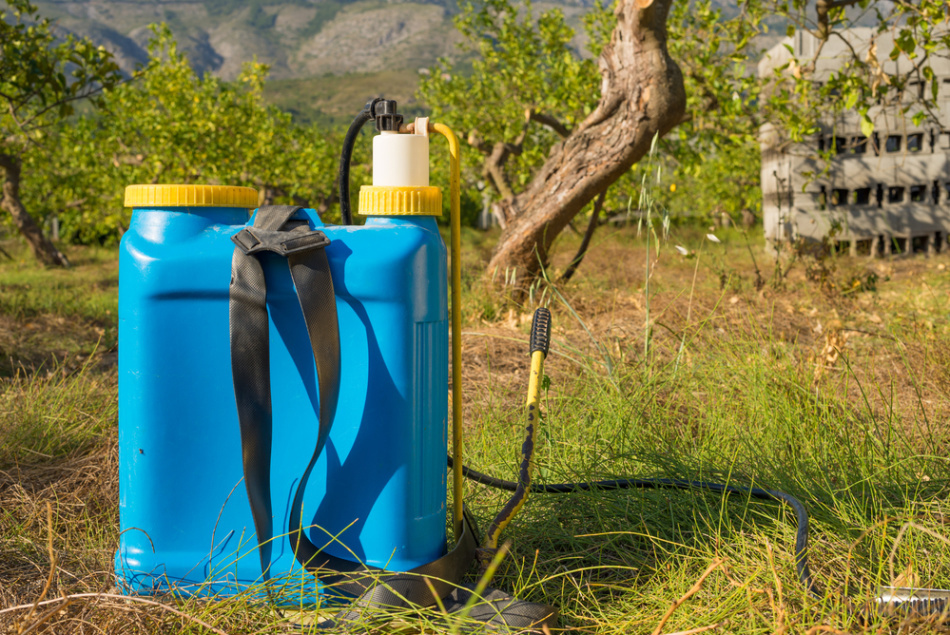 Herbicide spray
Herbicide spray Internet shops and specialized horticultural centers offer a wide range of chemical agents for controlling stubble:
- Rounddown
- Hurricane Forte
- Agro-killer
- Glyphos
- Tornado
- Ground
- Fusilad Forte
IMPORTANT: Chemical methods for influencing wheatgrass are effective, but it should be remembered that by removing the "importunate" weed from the garden with the help of herbicides, a person causes irreparable damage to living soil and its inhabitants. Plants planted on such a land, for a long time will be under the influence of these reagents. According to scientists, herbicides on one site should not be used more than once in three years.
When working with chemical herbicides, personal protective equipment should be used: glasses, respirators, gloves, dense clothing that does not allow the herbicide to enter the skin.
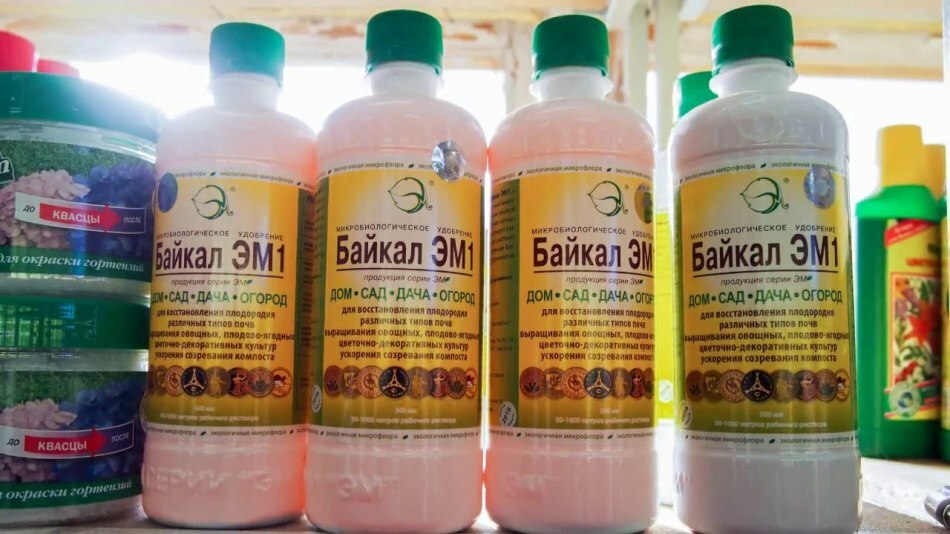 Preparation Baikal EM1
Preparation Baikal EM1 New technologies in combating grasshopper
Along with strong chemical herbicides, science presents new drugs that do not act detrimental to the soil composition and its inhabitants. Scientists-biochemists have found strains of microorganisms capable of feeding organic remains.
This, the so-called, EM-drugs. While treating the soil with these substances, the soil structure is not disturbed, but on the contrary, the balance of the soil cover and microflora is restored without digging and other traditional methods of farming.
When EM preparations are applied to the root system of weeds, they die as a result of EM fermentation. In addition, effective microorganisms are a remarkable microbiological fertilizer.
Such preparations for tillage deserve attention:
- Baikal EM-1
- Shining
- Revival
- Tamir
- EM molasses
- Emix
- Humazate EM universal
Combating grasshopper in the garden: roundup
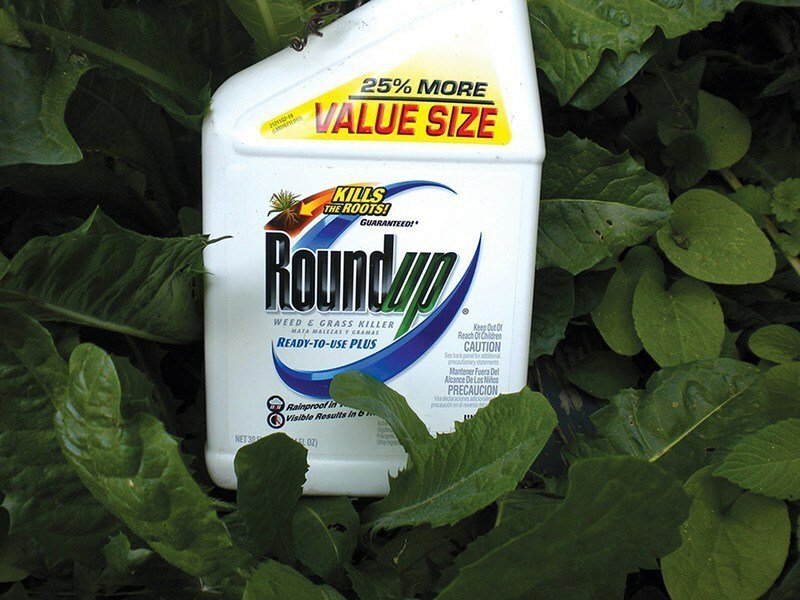 Herbicide Roundup received a well-deserved attention in the fight againstmany hard-to-be-harvested perennial grass weeds, in particular, with creeping grass. Herbicide of a new generation is characterized by many indicators that are trustworthy truckers.
Herbicide Roundup received a well-deserved attention in the fight againstmany hard-to-be-harvested perennial grass weeds, in particular, with creeping grass. Herbicide of a new generation is characterized by many indicators that are trustworthy truckers. High performance .Roundup completely clears the treated area from weeds
Safety .If the instructions for use are followed, the herbicide is practically harmless to people and the environment.
IMPORTANT: Roundup, due to its low toxicity, is listed in the register of authorized medicines by the Ministry of Health and the Ministry of Ecology of the Russian Federation.
Glyphosate - the active component of Roundup has a systemic effect. After spraying the weeds, the solution penetrates into all parts of the weed, reaching the root system 6-7 days after treatment.
Roundup treats the soil before sowing and after harvesting for the prevention of land before the next planting. Preparing the creepers for the cleavage is prepared according to the attached instructions. The solution destroys both individual plants and thickened grassy thickets.
Features of use of Roundup
- The working solution is sprayed into dry, windless weather with total absence of dew and rainwater on the leaves of weeds
- It is permissible to store the prepared solution within a week with a tight closure of the dishes where
- solution is stored. Before treatment with the herbicide, do not weed and mow the weeds
- .Roundup should not be carried out agrotechnical measures in the form of weeding, digging and loosening the soil for 5-7 days
- If the herbicide solutionand somehow got on the cultivated plant, it should be thoroughly washed with water
Remedy wheatgrass: Hurricane Hurricane Forte Herbicide

- Hurricane Forte is a systemic herbicide of continuous action. It has in its composition an active substance - glyphosate, is considered analogous to the herbicide Roundup with the same chemical reagent. Produced in different packaging containers, which is convenient for processing different sizes of areas of
- For spraying 1 hundred of garden, 20-40 ml of the preparation in 3-4 liters of water should be diluted. It is used before the pre-spring planting and after the end of agricultural work in autumn
- Completely removes such hard-to-remove weeds as crochet-grass, as it penetrates not only into the leafy part of the plant, but into the stem and root system. Hurricane Forte is a low-toxic drug and is approved for use. Safe for bees, the environment and people
IMPORTANT: When preparing the working solution, the preparation rules must be strictly adhered to, following the recommendations given in the instructions.
Advice from connoisseurs of : for a more efficient death of the root system of crocheted wheatgrass add 100-150 g of urea to 10 liters of the working solution of the herbicide. Ammonium nitrogen improves the delivery of the drug to the roots of a weed plant.
Propagation seders
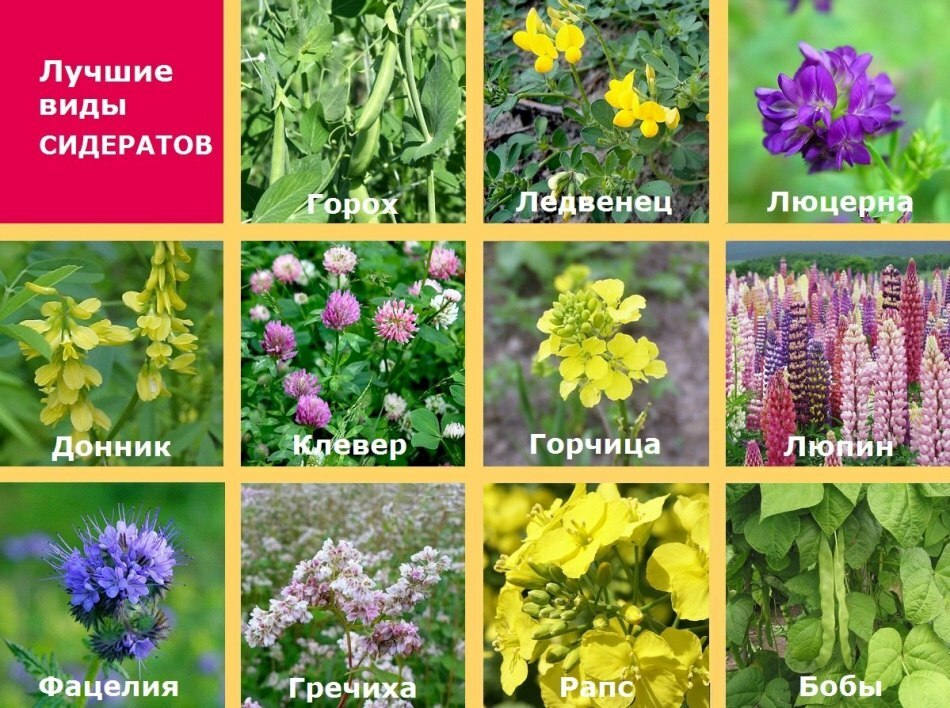 Soeder plants
Soeder plants Soil cleavage from wheatgrass with the help of plant-siderates is an organic method of cultivating the land. Seeding of the site with siderates does not affect the ecology of the environment and soil. The technique promotes not only the removal of weeds, but also the aeration of the land cover and the improvement of the soil structure.
The most common siderated plants are:
- Mustard Sarepta
- lupine
- phacelia
- buckwheat
- rape
- clover
- rye
- pea
Inoculate syderates on land areas after shallow plowing( flat Fokin, motoblock or cultivator) a month before planting or immediately after harvestingharvest.
Ciderates, growing larger, weed out weed grass from the site. In addition, the sloping and embedded grass of the siderates, in the soil, improve its quality, contribute to the natural aeration of the earth and its fertility. Seed siderates do not allow the root system of wheat grass to grow, gradually the soil will be cleared of malicious weed.
Potatoes for potatoes
 Potato field
Potato field - It is not difficult to prepare a bed for potatoes in the suburban area. Many gardeners prefer an ecological way of killing wheat grass on a small plot: the autumn digging of the earth with the subsequent selection of the rhizome. And to dig the soil follows the pitchfork to avoid rupture of the roots of the wheat grass, which provokes a new growth of the root system
- But how to deal with the weed in large areas of the potato field? This method will be very difficult. Without herbicides here is indispensable. Roundup, Tornado, Hurricane Forte - modern high-tech systemic herbicides that are applied by spraying on weeds according to the attached instructions for use
- Efficient late-fall soil treatment with reagents or after harvest. When spring spraying is recommended pre-sowing treatment of the site or 3-5 days before the emergence of the culture
Manual disposal with a grasshopper in small areas: video
How to get rid of strawberry in strawberries?
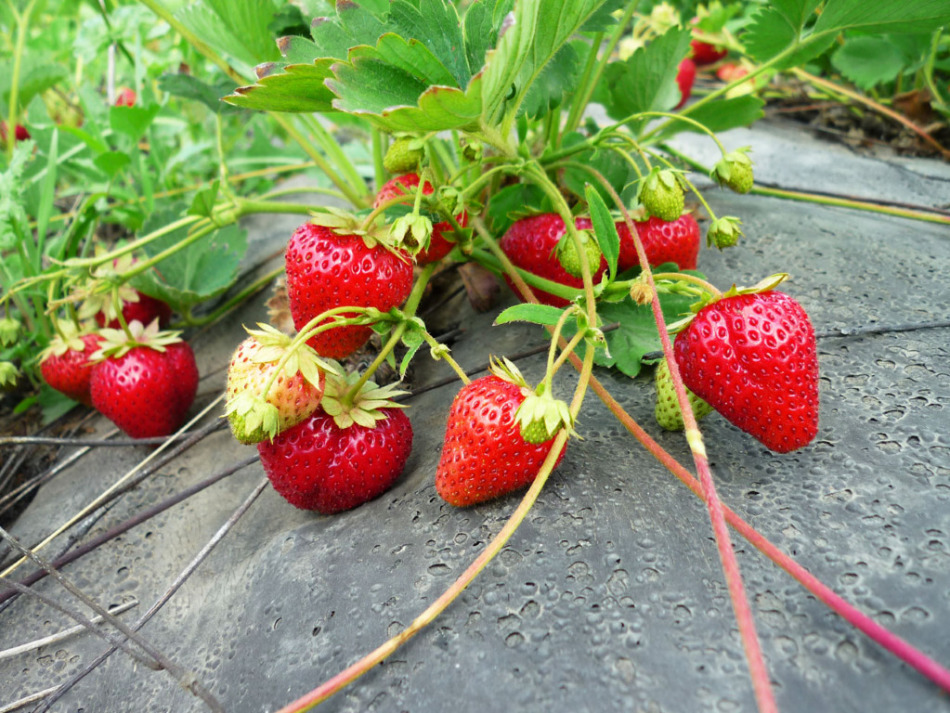 Growing strawberries
Growing strawberries Fighting stubble on strawberry beds is problematic, but possible. Let's give some tips on how to do this.
- If the wheatgrass captures the strawberry beds, you should discharge the planting. It is recommended to remove old and weak plants. This contributes to better ventilation between the strawberry bush and makes it possible to dig a growing wheat grass. Then we must manually remove the weed together with the root system
- . With a large accumulation of wheatgrass, the weed can be treated with a systemic herbicide. In this case, the spray method will not work. The working solution should be applied to the weed carefully with a brush, making sure that the herbicide does not hit the leaves of the strawberry. Herbicide treatment is best done in autumn after harvest
- Fusilad Forte is a systemic herbicide that is allowed to remove perennial cereals on strawberry beds. After treatment with the herbicide, soil loosening should not be carried out for two weeks. During this time, the rootstock of wheatgrass completely dies
IMPORTANT: Use herbicides for strawberries as a last resort, if possible, use other methods of combating weeds.
- Strawberry row spacing should be covered with sawdust or straw, this cover will not allow to break through the weeds
- To destroy the wheatgrass in strawberry, and other weeds, the method of growing berry culture on a mulching film will help. This method has found wide application in truck farmers recently
How to choose herbicides, video
How to get rid of wheatgrass in raspberry: herbicide
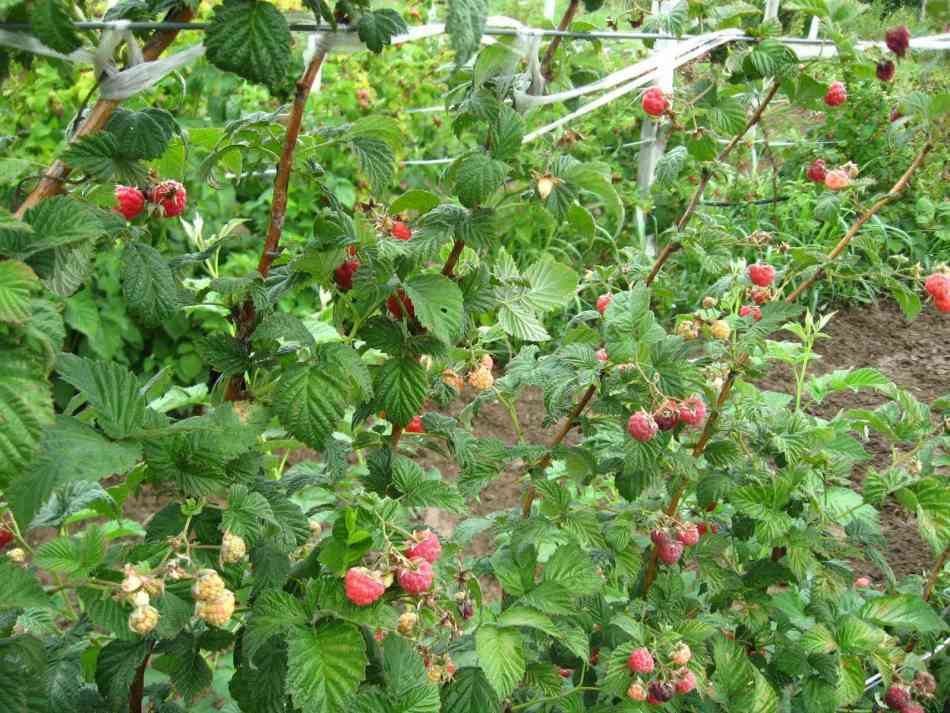 Malinnik
Malinnik - Pereyu creeping is a dangerous weed plant for raspberries. Since the berry bushes are responsive to the organics, raspberry and raspberry rows quickly overgrow with weeds. The root system of the weed is tightly intertwined with the roots of the raspberry, and the shilts( underground shoots) can even pass through them. Therefore, it is difficult to remove wheatgrass in the raspberry growth area
- . Piles can be selected by selective treatment with herbicides of continuous action: . Round , . Tornado , Agrokiller , Hurricane Forte .The working solution is prepared strictly according to the instructions. Weed plants are treated with a brush over the surface of the aerial part of the weed. In doing so, you should pay attention to the working solution does not fall on the young raspberry shoots
IMPORTANT: An alternative to chemical control of wheatgrass is the method of mulching rows of berry bushes with sawdust, straw. Mulch does not allow us to grow weeds and keeps the soil moist.
How to deal with the grass on the lawn?
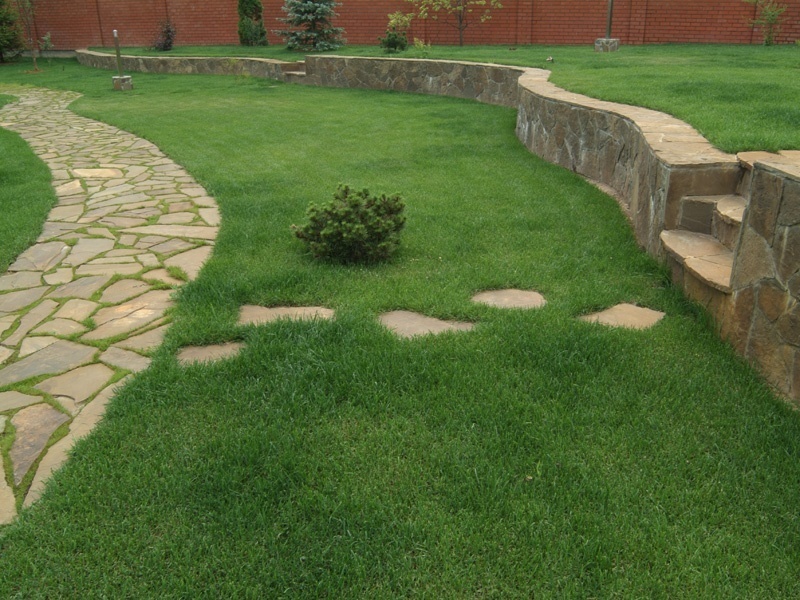 Plows on the lawn
Plows on the lawn - Spring is considered the best time to remove couch grass, like all weeds. When there are single specimens of wheatgrass on the lawn, immediately remove them with the root, without damaging the roots of the
- . If this is not done at once, the fast-growing and ubiquitous roots of the wheat grass quickly occupy a large part of the lawn. In addition, there is a chance for the plant to ripen and scatter seeds in the well-groomed lawn area. Then with a grasshopper it is necessary to struggle in other ways and it will take much longer
- When planting lawn grass it is necessary to completely protect the soil from weeds. It is best to use herbicides before sowing the herbs. But, if a well-grown grass grows on a well-groomed lawn, sow, dandelions, which are difficult to fight by hand, select herbicides of selective action. For these purposes, the Agrokiller
is very well proven. Combating stamping with folk remedies
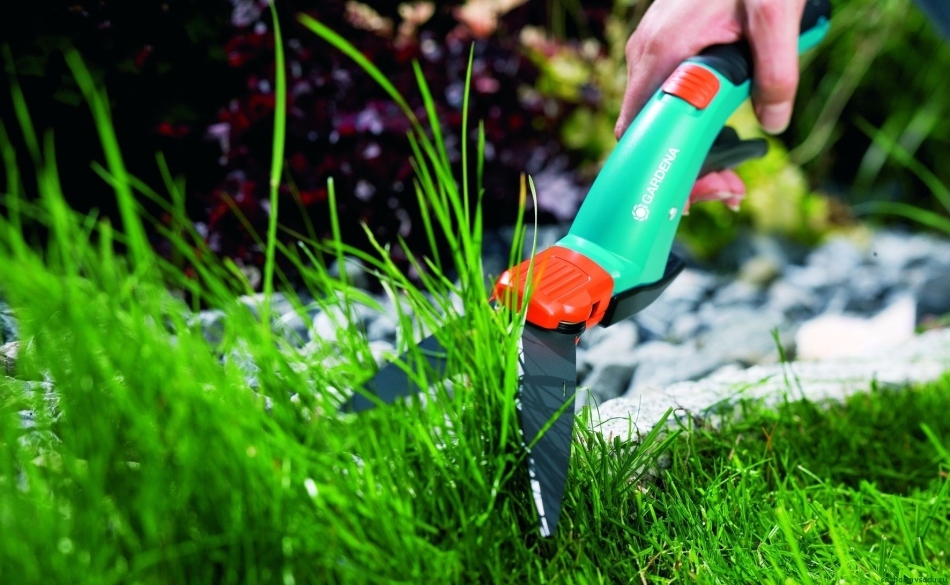 Popular methods for combating grasshopper are available and effective.
Popular methods for combating grasshopper are available and effective. Pyrus so annoys gardeners and gardeners that everything goes in the way - like the latest chemical preparations and time-tested folk methodsand means. Let's share the most common and available recipes for getting rid of malicious weed.
Soda
Sodium bicarbonate or baking soda can easily be purchased in any supermarket or pharmacy. A fairly aggressive reagent will help destroy individual specimens of wheat grass and other weed grass between the tiles of the garden path or recreational areas. To do this, prepare a strong soda solution and shed it on the beaten grass.
Salt
Sodium chloride or food salt is also a cheap means of getting rid of weeds. Crystals of salt should be spread over weeds around the planted crops. After watering, the salt will soak into the soil and inhibit the germination of a new weed.
Soldering Lamp Burning out, literally, a young seedling with a soldering lamp, is an effective method of getting rid of a green enemy. It is a pity that this method does not allow you to remove the root system of perennial wheat grass.
Destruction of weeds using a blowtorch: video
Fodder grain
- The method has found wide application in foreign countries. Sufficient testing and positive results give rise to the use of this method for controlling weeds
- . Fodder grain is grain waste when processing maize, oats, wheat and other cereals. Basically used for the production of feed for livestock and poultry
- The mechanism of action of forage grains on weeds is the presence of a specific gluten, which acts as a contraceptive for the germination of weeds.
- The method is applied in the middle of the season, when cultivated plants have grown and have acquired a sufficient root system. Fodder grain wakes up around cultivated plants in a small layer and blocks the emergence of new weeds from
seeds Ethyl alcohol
 Ethyl alcohol for weed control
Ethyl alcohol for weed control The method for treating the soil with diluted ethanol before planting came to us from America. I'm afraid that our summer residents are unlikely to follow the foreign council. How can you pour such a valuable product into the ground? But the way has the right to exist. Besides, as the American farmers say, the site treated by this method will not overgrow with weeds, at least this season.
Ethyl alcohol is diluted with water in a proportion of 1:10.The resulting solution is treated with soil about 30 days before planting.11 liters of this mixture is enough for processing 2-2,5 hundred parts of the site.
Citric acid
In 1 liter of hot water, dissolve 3 tablespoons of citric acid. The weeds are sprinkled with the solution in a sunny, windless weather.
Mulching
The principle of mulching is the complete concealment of access, sun and air to germinated weeds and the inability to penetrate their seeds. Mulching material provides reliable protection against weed grass to garden plants and flower crops.
As mulching material can be used:
- polyethylene film or woven fiber
- sawdust
- expanded clay or gravel
- crushed bark of trees
- mowed grass
- tool material
To remove a large accumulation of wheatgrass in beds you need to be patient to wait for the result to take 3-4 months.
- To begin mark the beds for growing garden crops
- The surface of the marked land is tightly covered with film, cardboard, old linoleum or dense matter
- Above you can pour a bulk layer of mowed grass or straw
- After 3-4 months, the shelter can be removed and treated with soil
- Remove the wheat grassThis way it is possible in early spring, when the plant only begins to show from under the ground. For the winter it is also possible to swell the areas with lees
Combating stamping in the garden with vinegar
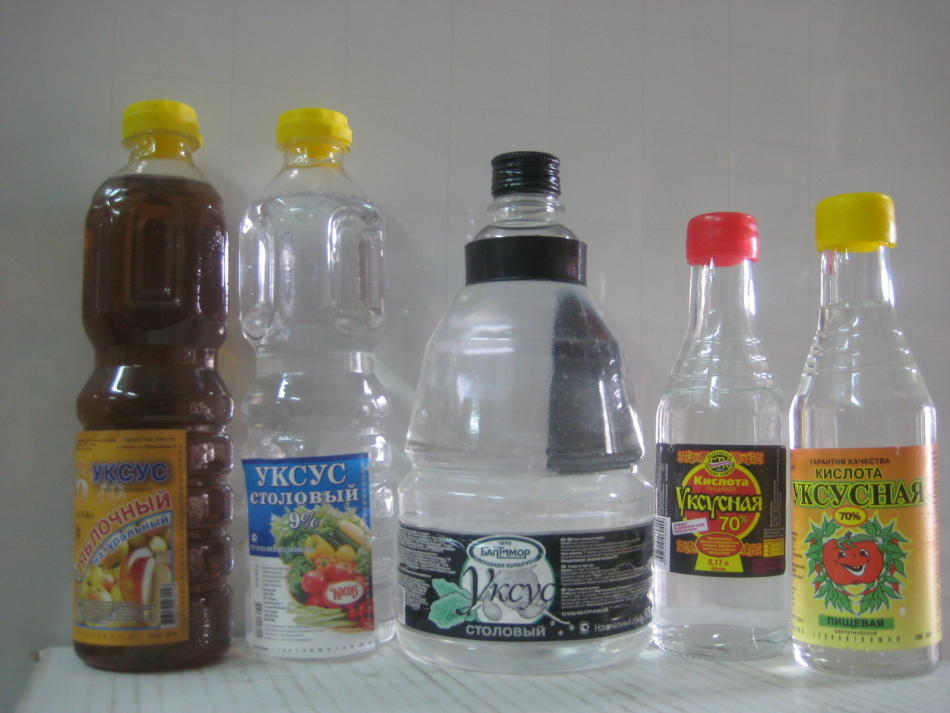 Vinegar in combating weeds
Vinegar in combating weeds Experienced dacha owners have long known a method for controlling stamens and other perennial weeds with the help of acetic solution.
For the preparation of herbicide soap "Killer of weeds" take:
- strong vinegar( 15-20%) - 3.8 l
- table salt - 0, 5 glasses
- any detergent - 1 teaspoon( for better adhesion of the solution)
- All componentsshould be properly mixed
- Treated in the morning in dry weather
- Copiously sprinkled the entire surface of weed grass
Treatment with ordinary 9% table vinegar from the spray also contributes to the death of leafy weeds.
This treatment method is effective for eradicating annual weeds. In case of leeks and other perennial grasses - the method is only suitable for removing the green mass of the plant. The root system of wheatgrass remains in the ground and after a while a young weed grows to conquer new land areas.
IMPORTANT: The vinegar is a fairly strong reagent, so you should carefully spray it, not getting onto the crop plants.
Pumpkin against grasshopper
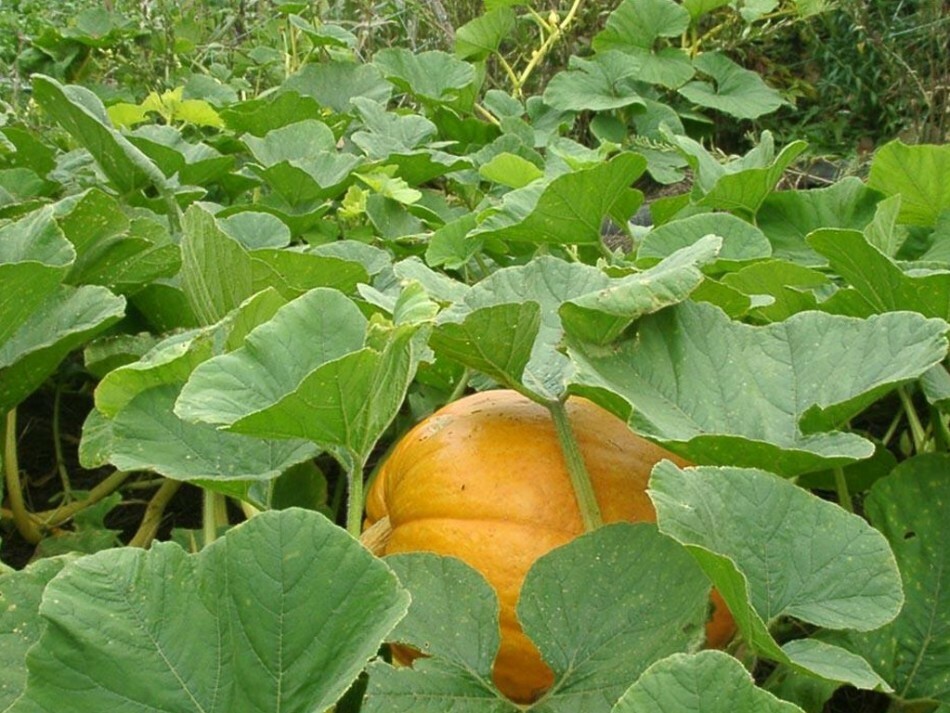 Pumpkin fighting weeds
Pumpkin fighting weeds - The American Indians were the first to use a pumpkin in the fight against weeds. They used a pumpkin, corn and beans in joint plantings. Large pumpkin leaves covered the soil from weed plants, and corn gave support for the growth of beans. An ecological and simple method should be adopted.
- On a plot covered with weed and other weeds cut pieces of sod with dimensions of 30x30 cm at a distance of 1 m from each other. The sod is turned upside down by the root system. On the cut pieces put a pumpkin
- At the rows between the weeds. This is done once, then the large leaves of the pumpkin will close the surface of the site and the weeds will not grow. This method will free us from the weeds and the boundary of the site. To do this, pumpkin seeds are planted along the fence of the site, and the lashes are allowed in the side of the border
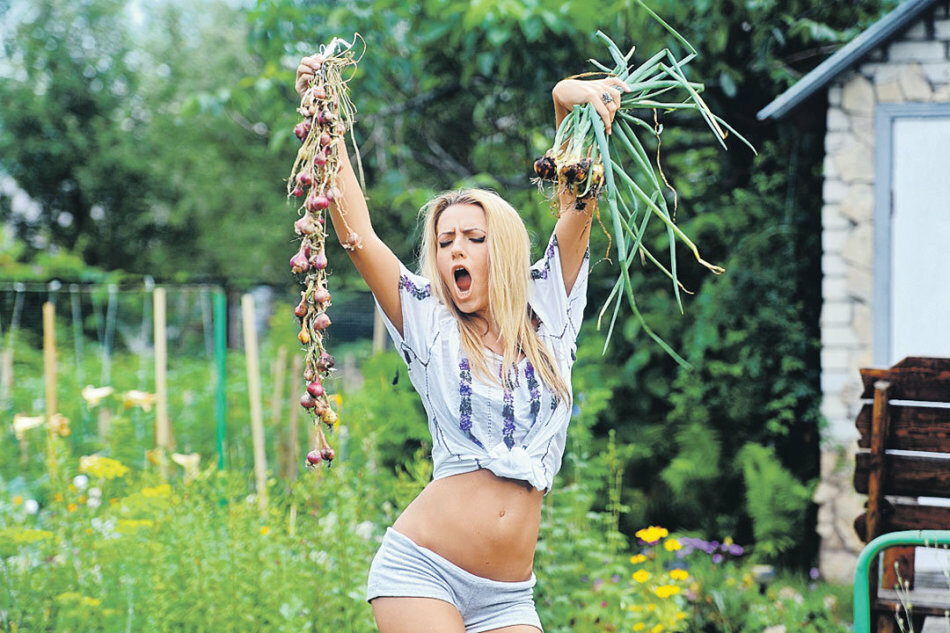 Every trucker has the right to decide which method to choose in combating weeds
Every trucker has the right to decide which method to choose in combating weeds So what to choose?
At the end let's summarize. Ogorodniki are combating the grasshopper in the following directions:
- mowing and weeding grass
- digging the soil with the subsequent selection of the rhizome
- removing the grass with the cover materials and mulch
- chemical effect on the weed with herbicides and other reagents
It is impossible to say which method is better, each has its ownadvantages and disadvantages.
- It will be necessary to mow and weed grass several times during the summer. This method removes the wheat for a short time. After all, the creeping root of the plant continues to remain in the soil and grows farther
- Choosing a rhizome from a dug ground is a rather long and time-consuming way to get rid of wheat grass. It's a shame that such a tedious job will not guarantee the complete destruction of the weed. Broken roots can not all be selected from the earth. Over time, they will give life to a new seed
- Herbicides are coping admirably with their task of destroying a harmful plant. But, we can not guarantee that the chemical agent will not fall on other garden plants, and together with them on the table
- Shelter beds, covered with grass, covering material and mulch - an effective and safe method of disposal of weeds
- Sowing sowing is an ecological methodgetting rid of weeds in organic farming
 Vintage without weeds
Vintage without weeds And at the end of the article - bonus:
The right advice: how to effectively deal with weeds on the site?
- Methods for organic farming and beds Mitlajdera - an ideal solution for combating weed grass
- Spot application of fertilizing and fertilizing will not allow the possible prosperity of weed plants. To introduce fertilizers should be only before planting and in the places of future growth of plants. The arbitrary application of fertilizers only stimulates the growth of weeds. In the future, seasonal top-dressing should be done
- Early spring weed control: weeding and physical removal of weeds with a root system will help not to "start" the site. Do not forget about the sap and rake in the future. Carry out sanitary weeding throughout the season
- Mulching is your reliable ally in the fight against weeds. Use mulch in beds, flower beds, on the paths between beds, in the trunks of fruit trees.
- . Using a black film on beds with strawberries, zucchini, tomatoes and other crops will help to avoid the weediness of the
- . The use of drip irrigation is a revolutionary breakthrough in growing plants. The benefit of such irrigation is not only in the economical use of water, but also in the targeted delivery of life-giving moisture to the right plants, leaving to ruin weeds without water.
- . Do not leave the soil bare. It should be immediately covered with black film, planted with syderates or cultivated plants.
- Annual crop rotation promotes the eradication of weed grass.
- . The primary way to grow the plant is seedling, and not through
seeds. IMPORTANT: It should be remembered: to achieve effective results in combating the most malignant weedsis possible only with a planned struggle, and not in the episodic destruction of them.
